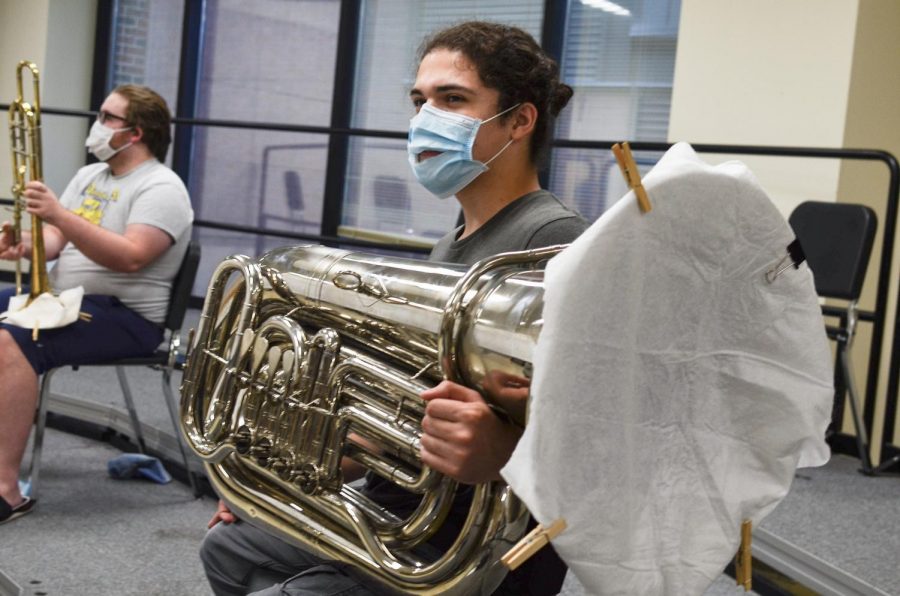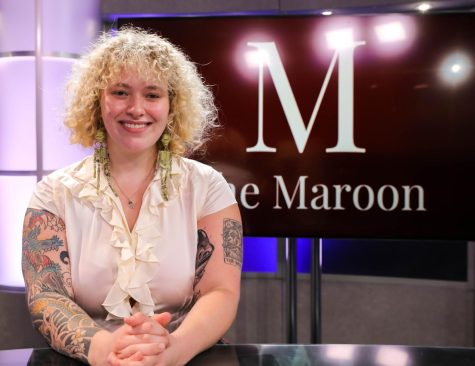Loyola’s ensembles play on while the world is on pause
Senior music major Albert Bustillo sits with his tuba during a brass quintet rehearsal. Small ensembles, like his brass quintet, have replaced the orchestras and bands this semester as a result of COVID-19 related restrictions.
September 24, 2020
Even when the world is on pause, Loyola School of Music instrumental students continue to play in smaller ensembles to build instrumental skill, learn to perform with other people and have communal jam sessions.
“It’s very magical, in a way, when you have a group of people coming together, able to have a unified voice and expressing that voice with their feelings and passions for music,” director of orchestral studies professor Jean Montès said. “It is very special and impossible to duplicate online.”
The School of Music divided students into smaller chamber ensembles based on their instruments, according to Meg Frazier, director of the School of Music.
During the spring semester and summer, Frazier said she and her faculty have researched aerosol studies to learn how students can play music together and stay safe.
According to Frazier, studies show it is important to minimize contact between students and the amount of time they’re meeting together.
“A band of 70 people might not have any aerosol transmission whatsoever after two minutes but have a whole lot after five or 10, depending on what’s going on,” Frazier said.
One day weekly, band and orchestra ensembles meet in large air volume performance spaces such as the band hall, choir and string rooms. According to Frazier, students are spaced 12 feet apart from each other and rehearse for 45 minutes maximum.
Orchestral studies music senior Joey Troia felt the transition was difficult, but he was excited to play with other musicians again.
“The feeling of reacting to what they’re doing and just listening to sound––there’s nothing like it,” Troia said. “I did a lot of recording over the summer with Zoom, and it never felt right, and I think listeners would agree that something was off.”
Troia said he is excited to play music with other people like old times, but he acknowledged that the ‘new normal’ brings mandatory safety protection for student musicians and their instruments to wear.
Frazier ordered bags that enclose woodwind instruments, face masks with slits and flaps for mouth pieces, and bell covers for brass players, like Troia, to limit the amount of water droplets blown into the air while playing.
“Band director Dr. Serena Weren is on the front line of wind, brass and percussion safety and gave us recommendations for what to order,” Frazier said.
Frazier said that the pandemic has forced many students online, but the School of Music is striving to create a sense of community.
Students are experimenting digitally by recording themselves and submitting their individual videos to be edited with their ensembles to produce one unified sound, according to Montès.
“The biggest change is just having that leadership opportunity. That’s something a lot of people don’t think of, especially in schools,” Troia said. “When the new freshman class is coming in, we want to meet them and show them the way, especially those that are seniors. Now, the role that I play with them is minimized.”
Troia felt that the safety precautions are not preferable for most students, but it keeps them safe and challenges him in new ways as a musician.
“They’re a whole world of music people, teachers, professional people and student musicians who are missing what we love to do,” Frazier said. “I’m happy we’re able to give our students some sort of ensemble experience, even if it’s not the standard large groups that we’re used to.”









